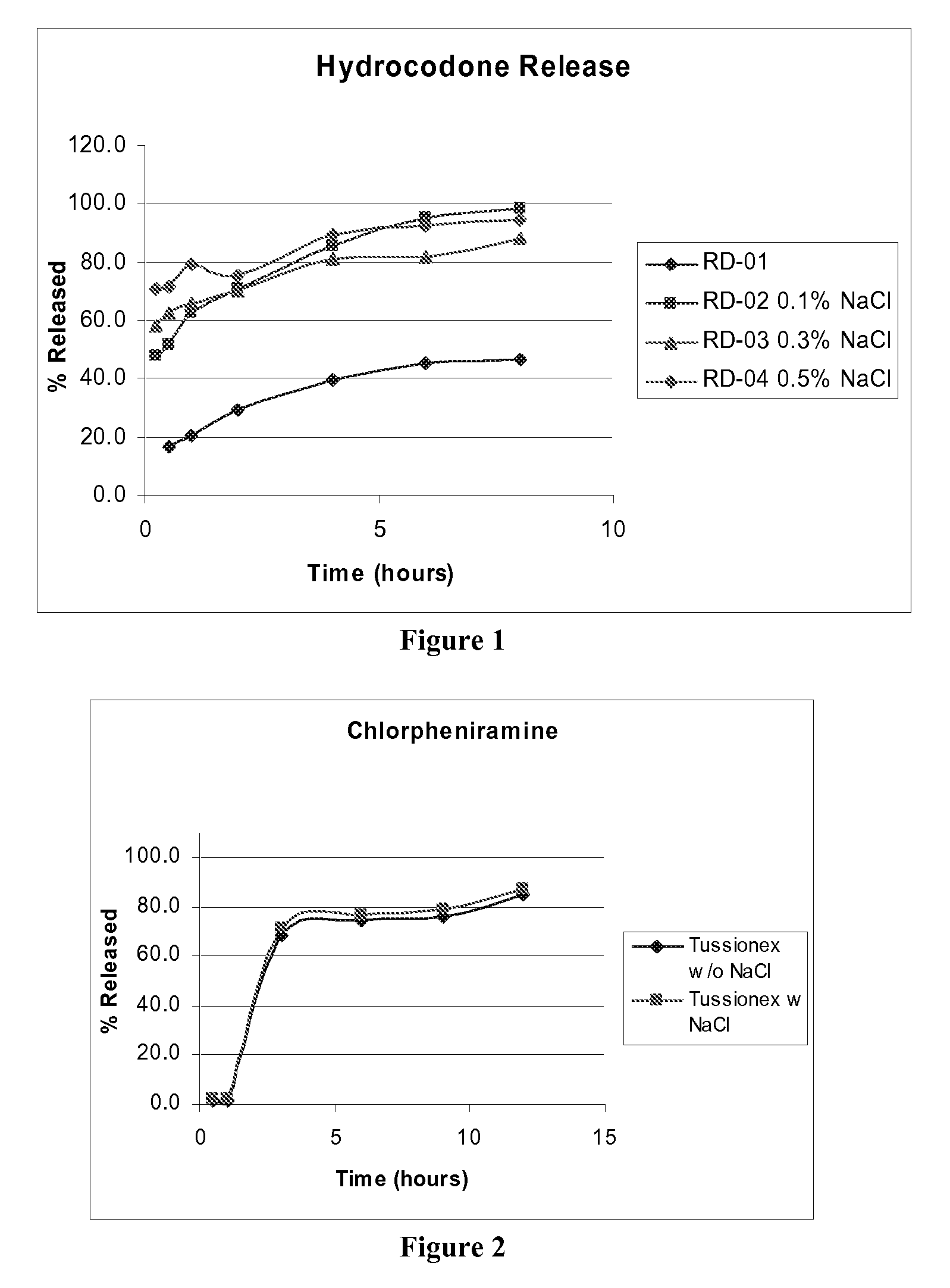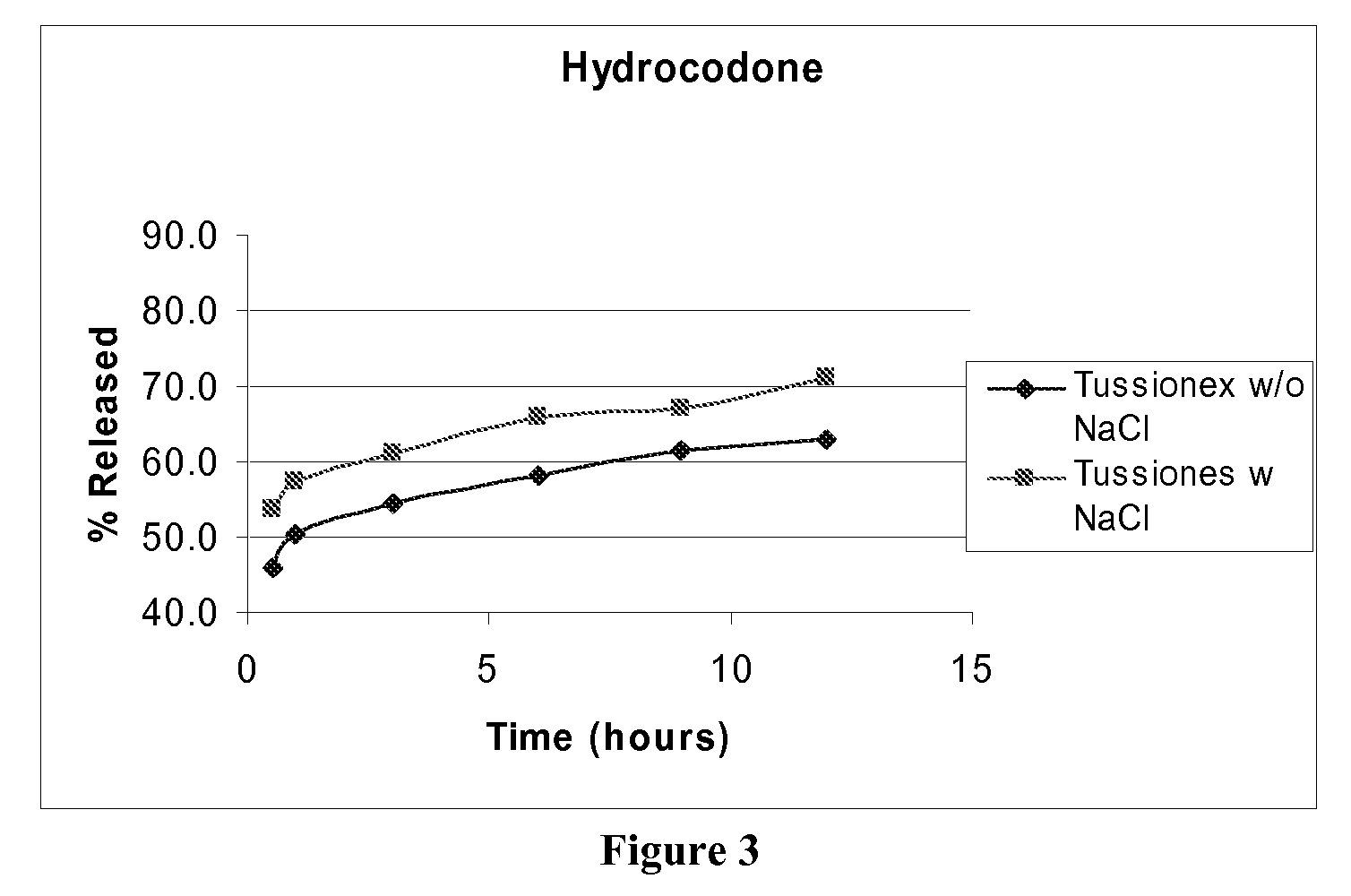Modifying Drug Release in Suspensions of Ionic Resin Systems
a technology of ionic resin and drug release, which is applied in the direction of dispersed delivery, synthetic polymeric active ingredients, organic non-active ingredients, etc., can solve the problems of inability to large-scale production in facilities, inconvenient drug release profiles, and many children and adults who fail to comply with dosing instructions, etc., to achieve rapid release of one active agent, improve the consistency of the release profile, and improve the effect of consistency
- Summary
- Abstract
- Description
- Claims
- Application Information
AI Technical Summary
Benefits of technology
Problems solved by technology
Method used
Image
Examples
example 1
APAP-Hydrocodone Suspensions
[0073]A suspension formulated using the Hydrocodone Bitartarate Polistirex (Ion Exchange resin Drug complex) and Acetaminophen (APAP) was studied. Briefly, the APAP 500 mg / 5 ml dose, (purchased from Rhodia Inc, Cranburry, N.J., 08512, USA) was added in the formulation of Hdyrocodone Bitartarate Polistirex (Drug Resin conjugate) suspension. These suspension formulations were made in the Pharmafab Research and Development laboratory. It was expected that the APAP would release quickly and there would be a sustained release of the Hydrocodone. The dose of Hydrocodone is 10 mg / 5 ml. It is expected that if 50% to 60% of the Hydrocodone is released in the first hour then, the therapeutic effectiveness of the combination can be increased when given with immediate release APAP (as designed in this formulation). Since in this formulation the Hydrocodone resin conjugate is coated with sustained release coating material (Ethyl cellulose), the release of Hydrocodone ...
example 2
Tussionex® Marketed Product Study
[0078]A similar study was conducted using the marketed Tussionex product that contains Hydrocodone Polistirex equivalent to Hydrocodone Bitartarate (HCB) 10.0 mg / 5 ml and Chlorpheniramine Polistirex equivalent to Chlorpheniramine Maleate (CPM) 8.0 mg / 5 ml. Dissolution studies were performed on this marketed suspension with and without the addition of Sodium chloride. (Sodium chloride, Purchased from J T Baker, Phillisburg, N.J., 08865, USA, was added at a level of 0.3%) These suspensions were studied for release profiles in 0.1 N HCl at pH 1.2 using USP dissolution apparatus II with 900 ml of dissolution medium. Samples were withdrawn at predetermined time intervals and were analyzed for APAP and Hydrocodone content using HPLC analysis. The release of drug against time was plotted.
[0079]The first hour and 12 hour release of the drug was studied. The results are given in following table 2 and FIG. 2 for CPM and FIG. 3 for HCB
TABLE 2Drug release from t...
PUM
| Property | Measurement | Unit |
|---|---|---|
| time | aaaaa | aaaaa |
| melting point | aaaaa | aaaaa |
| pH | aaaaa | aaaaa |
Abstract
Description
Claims
Application Information
 Login to View More
Login to View More - R&D
- Intellectual Property
- Life Sciences
- Materials
- Tech Scout
- Unparalleled Data Quality
- Higher Quality Content
- 60% Fewer Hallucinations
Browse by: Latest US Patents, China's latest patents, Technical Efficacy Thesaurus, Application Domain, Technology Topic, Popular Technical Reports.
© 2025 PatSnap. All rights reserved.Legal|Privacy policy|Modern Slavery Act Transparency Statement|Sitemap|About US| Contact US: help@patsnap.com



